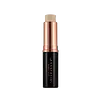Westman Atelier Face Trace Cream Contour Stick Versus Anastasia Beverly Hills Contour & Highlight Stick
What's inside
What's inside
 Key Ingredients
Key Ingredients

 Benefits
Benefits

 Concerns
Concerns

 Ingredients Side-by-side
Ingredients Side-by-side

Caprylic/Capric Triglyceride
MaskingKaolin
AbrasiveCaprylyl Caprylate/Caprate
EmollientSimmondsia Chinensis Seed Oil
EmollientPolyethylene
AbrasiveMica
Cosmetic ColorantPolyhydroxystearic Acid
EmulsifyingLecithin
EmollientBehenylcarbamoylpropyl Polysilsesquioxane
Tocopherol
AntioxidantAscorbyl Palmitate
AntioxidantCitric Acid
BufferingRubus Idaeus Leaf Cell Culture
Skin ConditioningTitanium Dioxide
Cosmetic ColorantCI 77891
Cosmetic ColorantIron Oxides
CI 77491
Cosmetic ColorantCI 77492
Cosmetic ColorantCI 77499
Cosmetic ColorantCI 73360
Cosmetic ColorantBlue 1 Lake
Cosmetic ColorantCI 42090
Cosmetic ColorantCI 15850
Cosmetic ColorantCI 19140
Cosmetic ColorantCaprylic/Capric Triglyceride, Kaolin, Caprylyl Caprylate/Caprate, Simmondsia Chinensis Seed Oil, Polyethylene, Mica, Polyhydroxystearic Acid, Lecithin, Behenylcarbamoylpropyl Polysilsesquioxane, Tocopherol, Ascorbyl Palmitate, Citric Acid, Rubus Idaeus Leaf Cell Culture, Titanium Dioxide, CI 77891, Iron Oxides, CI 77491, CI 77492, CI 77499, CI 73360, Blue 1 Lake, CI 42090, CI 15850, CI 19140
Phenyl Trimethicone
Skin ConditioningDimethicone
EmollientIsononyl Isononanoate
EmollientSilica
AbrasiveBis-Diglyceryl Polyacyladipate-2
EmollientOzokerite
Emulsion StabilisingPolymethyl Methacrylate
Triisodecyl Trimellitate
EmollientPolyethylene
AbrasiveMicrocrystalline Wax
Emulsion StabilisingEuphorbia Cerifera Wax
Kaolin
AbrasiveEthylhexyl Palmitate
EmollientIsopropyl Myristate
EmollientIsostearic Acid
CleansingLecithin
EmollientLimnanthes Alba Seed Oil
Skin ConditioningPolyglyceryl-3 Polyricinoleate
EmulsifyingPolyhydroxystearic Acid
EmulsifyingSimmondsia Chinensis Seed Oil
EmollientSodium Magnesium Silver Phosphate
AntimicrobialTocopheryl Acetate
AntioxidantIron Oxides
CI 77891
Cosmetic ColorantPhenyl Trimethicone, Dimethicone, Isononyl Isononanoate, Silica, Bis-Diglyceryl Polyacyladipate-2, Ozokerite, Polymethyl Methacrylate, Triisodecyl Trimellitate, Polyethylene, Microcrystalline Wax, Euphorbia Cerifera Wax, Kaolin, Ethylhexyl Palmitate, Isopropyl Myristate, Isostearic Acid, Lecithin, Limnanthes Alba Seed Oil, Polyglyceryl-3 Polyricinoleate, Polyhydroxystearic Acid, Simmondsia Chinensis Seed Oil, Sodium Magnesium Silver Phosphate, Tocopheryl Acetate, Iron Oxides, CI 77891
 Reviews
Reviews

Ingredients Explained
These ingredients are found in both products.
Ingredients higher up in an ingredient list are typically present in a larger amount.
Ci 77891 is a white pigment from Titanium dioxide. It is naturally found in minerals such as rutile and ilmenite.
It's main function is to add a white color to cosmetics. It can also be mixed with other colors to create different shades.
Ci 77891 is commonly found in sunscreens due to its ability to block UV rays.
Learn more about CI 77891Kaolin is a clay. It is used for oil control and to help minimize pores. Like other clays, kaolin has the ability to absorb excess sebum or oil. This can help clean out pores and mattify the skin.
Some types of kaolin may have exfoliating properties. When water is added to kaolin, it becomes a paste with small abrasive particles.
Most kaolin is a white color, but may be pink/orange/red depending on where it comes from.
The name 'kaolin' comes from a Chinese village named 'Gaoling'. Kaolin clay comes from rocks rich in kaolinite. Kaolinite, the mineral, has a silicate layered structure. Kaolinite is formed from chemical weathering of aluminum siilicate minerals.
Besides skincare, kaolin is commonly used to make glossy paper, in ceramics, toothpaste, and as medicine to soothe stomach issues.
Learn more about KaolinLecithin is a term for a group of substances found in the cell membranes of plants, animals, and humans. They are made up of mixture of phospholipids.
This ingredient has emollient and emulsifying properties.
As an emollient, lecithen helps soften the skin and creates a barrier to keep moisture in.
As an emulsifier, it also helps prevent water and oil ingredients from separating. Lecithin can also help ingredients be better absorbed by the skin.
This is because the phospholipids in lecithin produce liposomes. Liposomes help other ingredients get through the skin barrier.
Depending on the source of this ingredient, lecithin may not be fungal acne safe. This is because some sources of lecithin come from soybean oil, which may feed the malassezia yeast that feeds fungal acne.
We recommend reaching out to the brand you are purchasing from to inquire about the source of their lecithin.
Some other names for this ingredient include soy lecithin and deoiled soy lecithin.
Learn more about LecithinPolyethylene is a synthetic ingredient that helps the skin retain moisture. It is a polymer.
It is also typically used within product formulations to help bind solid ingredients together and thicken oil-based ingredients. When added to balms and emulsions, it helps increase the melting point temperature.
Polyhydroxystearic Acid is a soft wax made from castor oil.
It is is a texture thickener, emulsifier, and film-former. Emulsifiers prevent ingredients from separating, such as oils and waters.
Polyhydroxystearic Acid may not be fungal acne safe.
Learn more about Polyhydroxystearic AcidThis oil comes from the seeds of the desert shrub called Jojoba. It is more commonly known as jojoba oil, a non-comedogenic oil.
Jojoba oil does not contain fragrance and has many fatty-acids, making it a great soothing ingredient.
It also contains Vitamin E, a great moisturizing ingredient. Vitamin E is also an antioxidant and protects your skin against oxidative damage.
This ingredient humectant properties, meaning it helps draw moisture from the air. This helps keep your skin hydrated.
While jojoba has antibacterial properties, it is only able to kill some strains of bacteria.
Studies also show it helps in wound healing. In fact, Indigenous cultures have used jojoba as a moisturizer and to help treat burns for centuries.
Fun fact: Jojoba oil similar to natural human skin sebum, so it has a great effect on dry skin. It is also promising with helping to regulate sebum production.
Due to its fatty acid content, Jojoba oil may not be fungal acne safe. We recommend speaking with a professional if you have any concerns.
Learn more about Simmondsia Chinensis Seed OilThis ingredient is a combination of red, black, and yellow iron oxide pigments. This combination of colors is usually found in foundation, because it results in a "skin" color.